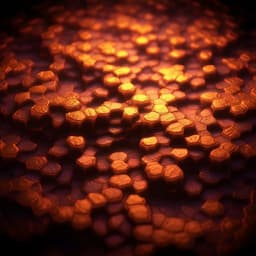
Physics
Twist-tunable polaritonic nanoresonators in a van der Waals crystal
O. G. Matveeva, A. I. F. Tresguerres-mata, et al.
Discover groundbreaking mid-infrared nanoresonators utilizing phonon polaritons in α-MoO3 van der Waals crystals. These innovative resonators achieve remarkable low losses and allow for twist-tunable spectral responses, empowering control over their resonances. This exciting research was conducted by a team of authors including O. G. Matveeva and A. I. F. Tresguerres-Mata.
~3 min • Beginner • English
Introduction
The excitation of phonon polaritons (PhPs) in van der Waals (vdW) crystals enables manipulation of mid-infrared light at deeply subwavelength scales for applications such as molecular fingerprinting and strong coupling. Certain vdW crystals (e.g., α-MoO3, α-V2O5) support long-lived, in-plane hyperbolic PhPs, making them attractive for ultra-low-loss optical nanoresonators. However, patterning vdW crystals to form resonators degrades their optical properties and PhP lifetimes, and unlike 2D plasmonic resonances, actively tuning PhP nanoresonators is challenging. The study demonstrates that by placing a pristine, unetched α-MoO3 slab on a grating of metallic nanoribbons and twisting the slab in-plane relative to the grating, one can realize low-loss PhP nanoresonators that are tunable by twist angle. Different refractive indices of PhP modes above air versus metal regions create refractive index steps, enabling multiple reflections and Fabry–Pérot resonances. Due to α-MoO3’s in-plane hyperbolicity, PhP momenta depend on propagation direction, so rotating the crystal axes with respect to the metal grating allows spectral tuning of the resonances. The work uses far-field FTIR and near-field s-SNOM to observe and disentangle the resonant PhP modes, with theoretical analysis to interpret the results.
Literature Review
Prior works established the importance of vdW polaritons for nanophotonics, including manipulation of IR light, molecular identification, and strong coupling (refs. 1–5). α-MoO3 and related biaxial vdW crystals exhibit in-plane hyperbolic PhPs with long lifetimes and anisotropic propagation (refs. 6–15), while fabrication-induced damage limits performance when vdW materials are structured (ref. 17). Unlike electrically tunable 2D plasmonic resonators (refs. 18–20), PhP nanoresonators have been harder to tune (refs. 21, 22). Concepts of electromagnetic-engineered resonators using unpatterned polaritonic slabs over metallic structures have been explored for isotropic materials such as h-BN and graphene (refs. 23–25). Analytical and experimental studies have characterized α-MoO3 permittivity and PhP waveguide modes in biaxial slabs (refs. 9, 26, 27) and anomalous reflection phases in graphene plasmons affecting FPRs (ref. 28). The present work leverages these insights to achieve twist-tunable, low-loss PhP nanoresonators in α-MoO3.
Methodology
Device concept and sample design: A continuous α-MoO3 slab (thicknesses used: 110 nm and 127.5 nm) is placed atop a periodic array of metal nanoribbons on an IR-transparent CaF2 substrate. The slab is twisted by an in-plane angle φ relative to the direction across the ribbons (x-axis). Ribbon width w and air gap d were designed to place resonances in the mid-IR (ω ≈ 850–1010 cm−1). Representative parameters: w = 1480 nm, d = 1230 nm; metal thickness ~50–70 nm.
Fabrication of metal ribbons: Arrays of Au and Al ribbons were fabricated by electron-beam lithography. For Al: 70 nm Al evaporated on CaF2; negative resist (MA-N2401) spin-coated (~90 nm), patterned (50 keV, 200 pA, 280 μC/cm2), developed (AZ726), etched by RIE in BCl3/Cl2 (40 mT, 100 W), and resist removed in O2 plasma; resulting gratings: 50 μm length × 60 μm width × 70 nm height with varied w. For Au: PMMA resist patterned (100 kV, 100 pA), developed (1:3 MIBK:IPA), 5 nm Cr/50 nm Au evaporated, lift-off to form 50 μm × 50 μm × 50 nm gratings with w = 1.48 μm. Al gratings used for dispersion mapping at fixed frequency (Fig. 4c,d); Au for all other measurements.
α-MoO3 flakes and twist transfer: α-MoO3 exfoliated from bulk (Alfa Aesar) using Nitto tape, then thinned on PDMS. Optically selected homogeneous flakes of target thickness and area. Dry transfer with micromanipulator: flakes aligned and twisted atop the metal grating, picked up with polycarbonate (PC), transferred at ~250 °C to liquefy PC; PC removed in chloroform at 100 °C to release the flake.
Far-field spectroscopy (FTIR): Varian 620-IR microscope + 670-IR spectrometer with MCT detector (400–6000 cm−1). Reflectance at normal incidence, linearly polarized across ribbons, spectral resolution 2 cm−1; spatial aperture matched to arrays. CaF2 substrates assure transparency; Au layer used as normalization reference. Relative reflection δR computed by normalizing R to a moving average.
Near-field nanoimaging (s-SNOM): Neaspec s-SNOM with QCL (890–1140 cm−1). Pt/Ir-coated AFM tips (ARROW-NCPt-50), tapping at Ω ≈ 280 kHz, amplitude ~100 nm. Tip-scattered light collected by parabolic mirror to IR detector; pseudo-heterodyne interferometry for amplitude and phase; demodulation at 3Ω for background suppression. s-SNOM maps Re(S3) correlated with simulated Re(Ez).
Numerical simulations: Full-wave finite-element (COMSOL) simulations in frequency domain. (1) Plane-wave illumination at normal incidence, polarization across ribbons; parameter ratio w/d fixed at 1480/1230; outputs: reflection spectra and vertical field Ez distributions above α-MoO3 (used for Fig. 2a–e, Fig. 3b–e). (2) Quasi-normal eigenmode analysis to obtain field profiles of M0 and M1 modes (Fig. 1c). Analytical FPR modeling used PhP reflection phases φm = 0 for α-MoO3/metal and φm = π for α-MoO3/air boundaries. Fabry–Pérot condition a·kM + φM = 2πn applied with a = w or d depending on region and kM from biaxial-slab dispersion.
Key Findings
- Twist-tunable, low-loss PhP nanoresonators were realized by placing a pristine α-MoO3 slab on metal ribbon gratings and rotating the slab in-plane relative to the grating.
- High quality factors without etching: Q ≈ 180 at 916 cm−1 and Q ≈ 200 at 993 cm−1, attributed to avoiding fabrication-induced degradation and leveraging long-lived in-plane hyperbolic PhPs in α-MoO3.
- Broad spectral tunability by twist: Resonances shift with twist angle φ from 0° to 45°. The main 1a peak shifts from ~909.5 cm−1 to ~877 cm−1. Overall tuning up to ~32 cm−1 (~6× the FWHM ~5 cm−1).
- Distinct PhP modes in air vs metal regions: Modes above metal (M1m) have much shorter wavelength (higher momentum) and stronger confinement than above air (M0/M1a), as shown by dispersion and field profiles.
- Fabry–Pérot resonance (FPR) mechanism: Resonances arise from multiple reflections at α-MoO3/air and α-MoO3/metal interfaces with different reflection phases (π and 0, respectively). Simulated δR maxima match FPR conditions using mode dispersions in a biaxial slab.
- Near-field validation: s-SNOM images at resonance frequencies show standing-wave fringes consistent with FPR orders in air and metal regions (e.g., at ω = 909 cm−1, 1 oscillation over air gap and 6 over metal). Extracted wavelengths match geometry: λ ≈ 1.29 μm fitting air gap d ≈ 1.23 μm (1a) and λ ≈ 249 nm consistent with w/6 ≈ 247 nm (6m).
- Angle-dependent tuning mapped experimentally and theoretically: δR spectra versus φ show clear dispersive shifts; simulations agree.
- Dispersion reconstruction: Using FPRs at fixed cavity momentum (2π/d) or fixed frequency (e.g., 908.5 and 911 cm−1) allows reconstruction of isofrequency curves and the 3D dispersion surface (hyperboloids) of the MO2 PhP mode. Experimental peak positions align with crossings of the FPR selection (cylinders/lines) and calculated IFCs.
- Compared to THz plasmonic resonators in anisotropic WTe2, these twist-tunable PhP resonators exhibit much higher Q (by > an order of magnitude), thanks to absence of electron scattering and no direct crystal structuring.
Discussion
The work addresses the challenge of achieving active tunability in phonon-polariton nanoresonators while preserving low losses in vdW crystals. By exploiting the in-plane anisotropy (hyperbolicity) of α-MoO3, the authors introduce twist angle as a continuous tuning parameter: rotating the crystal relative to the metal grating changes the PhP momentum component set by the cavity, shifting the Fabry–Pérot resonances. This avoids lithographic patterning of the polaritonic crystal, maintaining intrinsic low-loss properties and yielding high Q factors. The combination of FTIR and s-SNOM measurements with full-wave simulations confirms that the observed resonances are FPRs formed by PhP waveguide modes experiencing different refractive indices above air and metal regions and reflection phases at their boundaries. Mapping resonance positions across twist angles and cavity dimensions reconstructs the anisotropic dispersion surfaces, offering a powerful method for material characterization. The findings are significant for mid-IR photonics, enabling narrowband, tunable resonators suitable for sensing, emission control, and photodetection, with performance surpassing analogous plasmonic systems in terms of losses and Q.
Conclusion
The study introduces a class of Fabry–Pérot phonon-polaritonic nanoresonators based on a pristine α-MoO3 slab placed on metal ribbon gratings, enabling twist-controlled spectral tuning without etching the vdW crystal. The devices exhibit ultra-narrow resonances (Q up to ~200) and broad twist-induced tuning (~32 cm−1), validated by far- and near-field measurements and supported by full-wave simulations and analytical FPR modeling. The FPRs enable reconstruction of anisotropic PhP dispersion surfaces at fixed momentum or frequency, providing an alternative route to characterize vdW materials and their optical constants. Future directions include applying this twist-tunable, low-loss resonator concept to other vdW materials, leveraging the dispersion-reconstruction methodology for materials metrology, and exploiting the high-Q, tunable response for mid-IR molecular sensing and bar-coding applications.
Limitations
Limitations are not explicitly emphasized. Practical constraints observed include: (i) signal-to-noise limitations restrict clear determination of resonant features to twist angles up to ~45°; (ii) near-field fringe counts can be influenced by tip-launched PhPs, leading to minor deviations in oscillation numbers; (iii) demonstrated tuning range and mode mapping are bounded by available grating dimensions (w, d) and laser/spectrometer coverage. No systematic assessment of temperature stability, environmental robustness, or device-to-device variability is provided.
Related Publications
Explore these studies to deepen your understanding of the subject.







